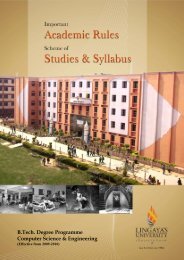Electrical and Electronics - Lingaya's University
Electrical and Electronics - Lingaya's University
Electrical and Electronics - Lingaya's University
Create successful ePaper yourself
Turn your PDF publications into a flip-book with our unique Google optimized e-Paper software.
B.Tech. <strong>Electrical</strong> & <strong>Electronics</strong> Engineering (Regular)6. D. C. MOTORS: Construction, principle <strong>and</strong>operation of D.C motors; back emf concept; torqueequation; power balance equation; Characteristicsof different types of DC motors, losses in DCmotors, efficiency, testing: Swinburne‘s,Hopkinson‘s, <strong>and</strong> retardation test.7. CONTROL OF DC MOTORS: Necessity of starter;3 point <strong>and</strong> 4 point starters. Speed control; fluxControl; armature resistance <strong>and</strong> armature voltagecontrol. <strong>Electrical</strong> Braking: Methods of electricalbraking i.e. dynamic, regenerative <strong>and</strong> plugging.TEXT BOOKBhimbara, P.S., ―<strong>Electrical</strong> Machinery‖, KhannaPublishers, 2000.REFERENCE BOOKS1. Kumar, K. Murguresh, ―DC Machines & Transformers‖,Vikas Publishing House Pvt. Ltd., 19992. Ghosh, Smarajit, ―<strong>Electrical</strong> Machines‖, PearsonPublishing, 2005.3. Bhimbara, P.S., ―Generalized Theory of ElectricMachines‖, Khanna Publishers, 19754. Kingsley, Fitzgerald C & Umans, S.D., ―ElectricMachinery‖, McGraw Hill Book Co., 1992.5. Say, M.G., ―Theory, Performance & Design of A.CMachines‖, ELBS 1986.6. Mcpherson George, ―Introduction to ElectricMachines & Transformers‖, John Wiley & Sons, 1980.EL-256ELECTRICAL MACHINES-ILAB.L T P Cr0 0 2 1LIST OF EXPERIMENTS:1. To find turns ratio <strong>and</strong> polarity of a 1-phasetransformer.2. To perform open <strong>and</strong> short circuit tests on a 1-phase transformer.3. To perform Sumpner's Back to back test on 1-phase transformers.4. Parallel operation of two 1-phase transformers.5. To convert three phase to 2-phase by Scottconnection.6. To perform load test on DC shunt generator.7. Speed control of DC shunt motor.8. Swinburne‘s test of DC shunts motor.9. Hopkinson‘s test of DC shunt M/Cs.10. Ward Leonard method of speed control.11. To plot o.c.c. Of D.C. Shunt generator12. To perform load test on DC shunt Motor.REFERENCE BOOKS1. Kumar, K. Murguresh, ―DC Machines & Transformers‖,Vikas Publishing House Pvt. Ltd., 19992. Ghosh, Smarajit, ―<strong>Electrical</strong> Machines‖, PearsonPublishing, 2005.3. Bhimbara, P.S., ―Generalized Theory of ElectricMachines‖, Khanna Publishers, 1975EL-301CONTROL SYSTEMSL T P Cr5 1 0 4OBJECTIVEProviding sound knowledge about the various controlsystem techniques required for the operation <strong>and</strong>accurate controls of Industrial processes <strong>and</strong> otherstrategies for complicated processes <strong>and</strong> efficientcontrol.PRE-REQUISITESKnowledge of Mathematics <strong>and</strong> <strong>Electrical</strong> Engineering1. INTRODUCTION TO CONTROL PROBLEM:Industrial control examples; Transfer functionmodels of mechanical; electrical; thermal <strong>and</strong>hydraulic systems; systems with dead- time,system response; control hardware <strong>and</strong> models:potentiometers; synchros; LVDT; dc <strong>and</strong> acservomotors; tacho-generators; electrohydraulicvalves; hydraulic servomotors; electropneumaticvalves; pneumatic actuators; closed-loop systems.Block diagram <strong>and</strong> signal flow graph analysis;transfer function.2. BASIC CHARACTERISTICS OF FEEDBACKCONTROL SYSTEM: Stability; steady-stateaccuracy; transient accuracy; disturbancerejection; insensitivity <strong>and</strong> robustness. Basicmodes of feedback control: proportional; integral<strong>and</strong> derivative. Feed-forward <strong>and</strong> multi-loop controlconfigurations.3. TIME DOMAIN ANALYSIS: Introduction;st<strong>and</strong>ard input signals; response of 1 st <strong>and</strong> 2 ndorder systems; time domain specifications i.e.;rise time; peak time; delay time; peakovershoot; settling time; steady state error etc.;different types of feedback systems; steadystate errors for unit ramp; unit step <strong>and</strong> unitparabolic inputs; effects of addition of zerostom the system.4. STABILITY ANALYSIS: Introduction; concept ofstability; conditions for stable system; asymptotic;relative <strong>and</strong> marginal stability; Routh-Hurwitzcriterion for stability <strong>and</strong> various difficulties withRouth-Hurwitz criterion.5. ROOT LOCUS TECHNIQUE: Introduction;concepts of root locus; construction of root loci <strong>and</strong>various rules pertaining to locus diagramdevelopment.6. FREQUENCY DOMAIN ANALYSIS ANDSTABILITY: Introduction; relation between time<strong>and</strong> frequency response for 2 nd order system;Bode plot; construction procedure for bode plot;gain cross over <strong>and</strong> phase cross over frequency;gain margin <strong>and</strong> phase margin; Nyquist plot <strong>and</strong>Nyquist stability criterion.7. STATE-VARIABLE ANALYSIS: Concept of state;state variable; state model; state models for linearcontinuous time functions; diagonalization of transferfunction; solution of state equations; concept ofcontrollability <strong>and</strong> Observability.TEXTBOOKNagrath <strong>and</strong> Gopal, ―Control System Engineering‖ ,New Age International, 2005REFERENCE BOOKS1. Ogata .K. ―Modern Control Engineering‘‘, PearsonEducation, 20002. Gopal Madan ―Control System – Principles &Design‖ Tata McGraw Hill, 19983. Dorl.R. C. & Bishop ―Modern Control Engineering‖,Addison Wesley, 1999.4. Kuo, B. C. ―Automatic control System‖, John Wiley& Sons, 199830
















